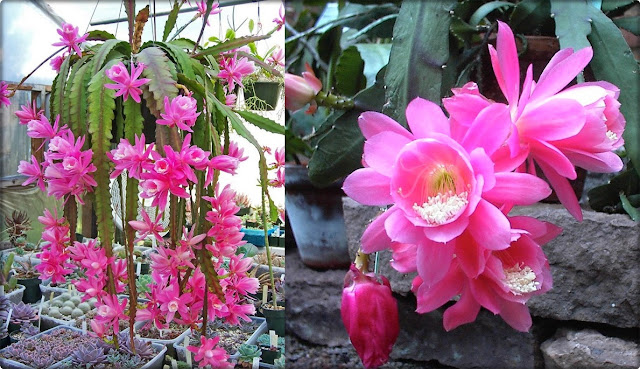Flowers for the most part are large, colorful, and funnel shaped and this genus is largely responsible for many of the popular "Epi" hybrids. Other flowers are more narrow and bilaterally symmetrical and some are even small and tube shaped.
 |
source: pinterest |
Scientific Name
Disocactus phyllanthoides (DC.) Barthlott
Common Names
German Empress, Giant Empress, Pond Lily Cactus
Synonyms
Cactus phyllanthoides (basionym), Cereus phyllanthoides, Epiphyllum phyllanthoides, Nopalxochia phyllanthoides, Phyllocactus phyllanthoides
Scientific Classification
Family: Cactaceae
Subfamily: Cactoideae
Tribe: Hylocereeae
Genus: Disocactus
Hardiness
USDA hardiness zones 9a to 11b: from 20 °F (−6.7 °C) to 50 °F (+10 °C).
How to Grow and Care
From the rainforest areas we can get a good idea of its growing requirements. This is a succulent that appreciates a moist soil mix, most growers use a mixture of peat, soil and pelrite, or sharp sand. Like many epiphytic plant part shade or filtered light is best.
Moisture is essential during the warmer months and a frost free environment is essential, during winter reduce watering, although do not allow to dry out completely. You will see the foliage begin to change and shrivel if watering is required.
Flowering mainly in spring, remember to keep Disocactus phyllanthoides fairly dry , but not completely dry during the dormant period, (winter).
Easy to grow from stem cuttings and although they will usually strike at any time of the year the best time is in spring.
- Do not be tempted to strike the long stems thinking you will get a larger plant more quickly.
- Shorter stems have a better strike rate.
- After cutting the stem, leave it in a shaded position to allow the cut to callous over, similar to many succulents.
- Cuttings will strike in the same potting mix you use for growing the parent plant. Leaf mold, perlite and sphagnum moss.
- Keep dry to just moist, this prevents damping off
- Cuttings should strike in 1 - 2 months.
- At this stage slowly bring them into more light to allow them to harden off gradually...
– See more at: How to Grow and Care for Disocactus
Origin
Disocactus phyllanthoides is native to Mexico (Puebla, Veracruz).
Links
Back to genus Disocactus
TIPS: Grow succulents: Browse succulents by Scientific Name, Common Name, Genus, Family, USDA Hardiness Zone, Origin, or cacti by Genus



